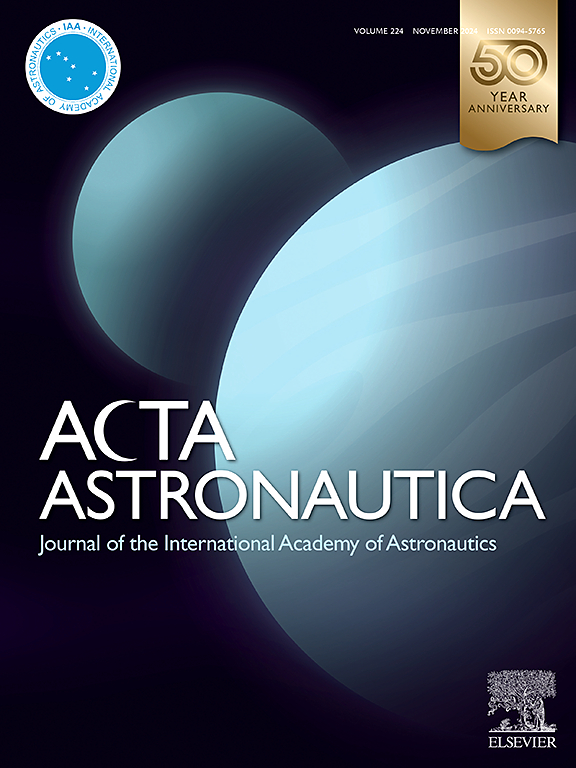CAMmary: A review of spacecraft collision avoidance manoeuvre design methods
IF 3.4
2区 物理与天体物理
Q1 ENGINEERING, AEROSPACE
引用次数: 0
Abstract
Ensuring safety for spacecraft operations has become a paramount concern due to the proliferation of space debris and the saturation of valuable orbital regimes. In this regard, the Collision Avoidance Manoeuvre (CAM) has emerged as a critical requirement for spacecraft operators, aiming to efficiently navigate through potentially hazardous encounters. Currently, when a conjunction is predicted, operators dedicate a considerable amount of time and resources to designing a CAM. Given the increased frequency of conjunctions, autonomous computation of fuel-efficient CAMs is crucial to reduce costs and improve the performance of future operations. To facilitate the transition to an autonomous CAM design, it is useful to provide an overview of its state-of-the-art. In this survey article, a collection of the most relevant research contributions in the field is presented. We review and categorise existing CAM techniques based on their underlying principles, such as (i) analytic, semi-analytic, or numerical solutions; (ii) impulsive or continuous thrust; (iii) deterministic or stochastic approaches, (iv) free or fixed manoeuvring time; (v) free or fixed thrust direction. Finally, to determine the validity of the algorithms potentially implementable for autonomous use, we perform a numerical comparison on a large set of conjunctions. With this analysis, the algorithms are evaluated in terms of computational efficiency, accuracy, and optimality of the computed policy. Through this comprehensive survey, we aim to provide insights into the state-of-the-art of CAM methodologies, identify gaps in current research, and outline potential directions for future developments in ensuring the safety and sustainability of spacecraft operations in increasingly congested orbital environments.
航天器避碰机动设计方法综述
由于空间碎片的扩散和宝贵轨道制度的饱和,确保航天器运行的安全已成为一个首要问题。在这方面,避免碰撞机动(CAM)已经成为航天器操作员的关键要求,旨在有效地导航通过潜在的危险遭遇。目前,当预测到连接时,作业者会投入大量的时间和资源来设计CAM。考虑到连接频率的增加,燃油效率cam的自动计算对于降低成本和提高未来作业的性能至关重要。为了方便过渡到一个自主CAM设计,它是有用的,提供其最先进的概述。在这篇调查文章中,收集了该领域最相关的研究成果。我们根据其基本原理对现有CAM技术进行了回顾和分类,例如(i)解析、半解析或数值解;(ii)脉冲或连续推力;(iii)确定性或随机方法;(iv)自由或固定操作时间;(v)自由或固定推力方向。最后,为了确定可能实现自主使用的算法的有效性,我们对一大组连词进行了数值比较。通过这种分析,根据计算策略的计算效率、准确性和最优性来评估算法。通过这项全面的调查,我们的目标是提供对CAM方法的最新技术的见解,确定当前研究中的差距,并概述未来发展的潜在方向,以确保航天器在日益拥挤的轨道环境中运行的安全性和可持续性。
本文章由计算机程序翻译,如有差异,请以英文原文为准。
求助全文
约1分钟内获得全文
求助全文
来源期刊

Acta Astronautica
工程技术-工程:宇航
CiteScore
7.20
自引率
22.90%
发文量
599
审稿时长
53 days
期刊介绍:
Acta Astronautica is sponsored by the International Academy of Astronautics. Content is based on original contributions in all fields of basic, engineering, life and social space sciences and of space technology related to:
The peaceful scientific exploration of space,
Its exploitation for human welfare and progress,
Conception, design, development and operation of space-borne and Earth-based systems,
In addition to regular issues, the journal publishes selected proceedings of the annual International Astronautical Congress (IAC), transactions of the IAA and special issues on topics of current interest, such as microgravity, space station technology, geostationary orbits, and space economics. Other subject areas include satellite technology, space transportation and communications, space energy, power and propulsion, astrodynamics, extraterrestrial intelligence and Earth observations.
 求助内容:
求助内容: 应助结果提醒方式:
应助结果提醒方式:


